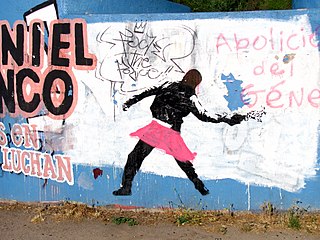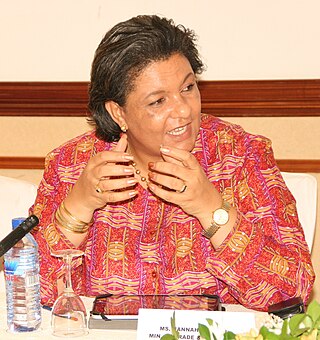
Polygyny is a form of polygamy entailing the marriage of a man to several women. The term polygyny is from Neoclassical Greek πολυγυνία (polugunía); from Ancient Greek πολύ (polú) 'many', and γυνή (gunḗ) 'woman, wife'.
Polygamy is the practice of marrying multiple spouses. When a man is married to more than one wife at the same time, sociologists call this polygyny. When a woman is married to more than one husband at a time, it is called polyandry. In sociobiology and zoology, researchers use polygamy in a broad sense to mean any form of multiple mating.
A mating system is a way in which a group is structured in relation to sexual behaviour. The precise meaning depends upon the context. With respect to animals, the term describes which males and females mate under which circumstances. Recognised systems include monogamy, polygamy, and promiscuity, all of which lead to different mate choice outcomes and thus these systems affect how sexual selection works in the species which practice them. In plants, the term refers to the degree and circumstances of outcrossing. In human sociobiology, the terms have been extended to encompass the formation of relationships such as marriage.

Postgenderism is a social, political and cultural movement which arose from the eroding of the cultural, psychological, and social role of gender, and an argument for why the erosion of binary gender will be liberatory.
While in ordinary speech, the terms sex and gender are often used interchangeably, in contemporary academic literature the terms often have distinct meanings, especially when referring to people. Sex generally refers to an organism's biological sex, while gender usually refers to either social roles typically associated with the sex of a person or personal identification of one's own gender based on an internal awareness. Most contemporary social scientists, behavioral scientists and biologists, many legal systems and government bodies, and intergovernmental agencies such as the WHO make a distinction between gender and sex.
Feminist sexology is an offshoot of traditional studies of sexology that focuses on the intersectionality of sex and gender in relation to the sexual lives of women. Sexology has a basis in psychoanalysis, specifically Freudian theory, which played a big role in early sexology. This reactionary field of feminist sexology seeks to be inclusive of experiences of sexuality and break down the problematic ideas that have been expressed by sexology in the past. Feminist sexology shares many principles with the overarching field of sexology; in particular, it does not try to prescribe a certain path or "normality" for women's sexuality, but only observe and note the different and varied ways in which women express their sexuality. It is a young field, but one that is growing rapidly.

A man is an adult human who is male. Prior to adulthood, a male human is referred to as a boy.

The status of women in Ghana and their roles in Ghanaian society has changed over the past few decades. There has been a slow increase in the political participation of Ghanaian women throughout history. Women are given equal rights under the Constitution of Ghana, yet disparities in education, employment, and health for women remain prevalent. Additionally, women have much less access to resources than men in Ghana do. Ghanaian women in rural and urban areas face slightly different challenges. Throughout Ghana, female-headed households are increasing.
Monogamy is a relationship of two individuals in which they form an exclusive intimate partnership. Having only one partner at any one time, whether that be for life or whether that be serial monogamy, contrasts with various forms of non-monogamy. More generally, the term is used to describe the behavioral ecology and sexual selection of animal mating systems, referring to the state of having only one mate at any one given time. In a human cultural context, monogamy typically refers to the custom of two individuals, regardless of orientation, committing to a sexually exclusive relationship.
Patriarchy is a social system in which positions of dominance and privilege are held by men. The term patriarchy is used both in anthropology to describe a family or clan controlled by the father or eldest male or group of males, and in feminist theory to describe a broader social structure in which men as a group dominate women and children.
Sexual division of labour (SDL) is the delegation of different tasks between the male and female members of a species. Among human hunter-gatherer societies, males and females are responsible for the acquisition of different types of foods and shared them with each other for a mutual or familial benefit. In some species, males and females eat slightly different foods, while in other species, males and females will routinely share food; but only in humans are these two attributes combined. The few remaining hunter-gatherer populations in the world serve as evolutionary models that can help explain the origin of the sexual division of labour. Many studies on the sexual division of labour have been conducted on hunter-gatherer populations, such as the Hadza, a hunter-gatherer population of Tanzania. In modern day society, sex differences in occupation is seen across cultures, with the tendency that men do technical work and women tend to do work related to care.
The Simbari people are a mountain-dwelling, hunting and horticultural tribal people who inhabit the fringes of the Eastern Highlands Province of Papua New Guinea, and are extensively described by the American anthropologist Gilbert Herdt. The Sambia – a pseudonym created by Herdt himself – are known by cultural anthropologists for their acts of "ritualised homosexuality" and semen ingestion practices with pubescent boys. In his studies of the Simbari, Herdt describes the people in light of their sexual culture and how their practices shape the masculinity of adolescent Simbari boys.
Strength theory, the strength hypothesis or strength differences is an idea in anthropology and gender studies. Scholars use it to explain why some cultures assign some forms of work to women and other forms of work to men. In a strength theory model, cultures give certain tasks to men because men are stronger.
Erotic plasticity is the degree to which one's sex drive can be changed by cultural or social factors. Someone has "high erotic plasticity" when their sex drives can be affected by situational, social and cultural influences, whereas someone with "low erotic plasticity" has a sex drive that is relatively rigid and unsusceptible to change. Since social psychologist Roy Baumeister coined the term in 2000, only two studies directly assessing erotic plasticity have been completed as of 2010.
Gendered sexuality is the way in which gender and sexuality are often viewed as likened constructs, whereby the role of gender in an individual's life is informed by and impacts others' perceptions of their sexuality. For example, both the male and female genders are subject to assumptions of heterosexuality. If a man were to behave in feminine ways, his heterosexuality would be doubted, and individuals may assume that he is gay.
Promiscuity tends to be frowned upon by many societies that expect most members to have committed, long-term relationships. Among women, as well as men, inclination for sex outside committed relationships is correlated with a high libido, but evolutionary biology as well as social and cultural factors have also been observed to influence sexual behavior and opinion.

In evolutionary psychology and behavioral ecology, human mating strategies are a set of behaviors used by individuals to select, attract, and retain mates. Mating strategies overlap with reproductive strategies, which encompass a broader set of behaviors involving the timing of reproduction and the trade-off between quantity and quality of offspring.
Ernestine Friedl was an American anthropologist, author, and professor. She served as the president of both the American Ethnological Society (1967) and the American Anthropological Association (1974–1975). Friedl was also the first Dean of Arts and Sciences and Trinity College at Duke University, and was a James B. Duke Professor Emerita. A building on Duke's campus, housing the departments of African and African American Studies, Cultural Anthropology, the Latino/Latina Studies program, and Literature was named in her honor in 2008. Her major interests included gender roles, rural life in modern Greece, and the St. Croix Chippewa Indians of Wisconsin.
The economy-of-effort theory is an idea in anthropology and gender studies. Scholars use it to explain why some cultures assign some forms of work to women and other forms of work to men. In an economy-of-effort scenario, a given task is assigned to men or women not because of differences in their physical bodies but because other things about that culture's gender roles make it more efficient than otherwise.
The compatibility-with-childcare theory is an idea in anthropology and gender studies. Scholars use it to explain why some cultures assign some forms of work to women and other forms of work to men. In cultures that assign the care of young children to women, other roles given to women must not involve traveling long distances away from those children for extended or unpredictable periods. For example, hunter-gatherer and horticultural societies assign the hunting of large game almost exclusively to men. Anthropologist Ernestine Friedl hypothesized that this could be because women take primary responsibility for the care of young children, and the long and unpredictable absences and long distances involved in this type of hunting would make that prohibitively difficult.





